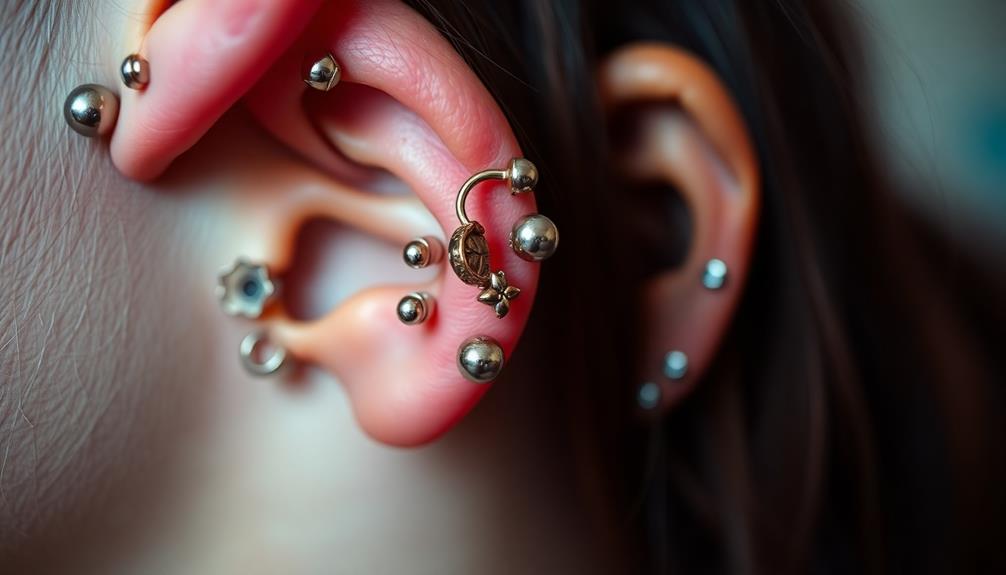Workplace policies on visible piercings often aim to balance your personal style with professional standards. Employers may restrict facial piercings or limit the number of earrings to maintain a polished image, especially in conservative industries. Sometimes, you’ll need to cover piercings during client meetings or formal hours to show respect for company norms. If you want to understand how these policies might apply in your workplace and how to express yourself appropriately, there’s more to contemplate.
Key Takeaways
- Workplace policies aim to balance personal expression with maintaining a professional image.
- Dress code boundaries vary by industry, with conservative fields restricting visible piercings more than creative sectors.
- Perceptions of professionalism may be affected by the size and visibility of piercings in the workplace.
- Some employers require concealing piercings during client interactions to uphold a neutral, professional appearance.
- Respecting dress code policies fosters a cohesive environment and helps avoid misunderstandings or conflicts.

Many workplaces are establishing policies regarding visible piercings to balance personal expression with professional standards. They want to create environments where employees feel comfortable expressing themselves without compromising the company’s image. When it comes to dress code, employers often set clear boundaries to maintain a consistent and professional appearance. Visible piercings, such as nose rings, eyebrow studs, or multiple earrings, can sometimes clash with these standards, especially in industries that prioritize a traditional or conservative look. You might find that some workplaces view excessive or highly noticeable piercings as distracting or unprofessional, which could impact how colleagues and clients perceive your role.
Understanding your company’s stance on visible piercings is vital. Many organizations specify what is acceptable within their dress code to ensure uniformity and professionalism. For example, a corporate office might restrict facial piercings or limit the number of earrings to uphold a polished image. Conversely, creative industries like fashion or design might be more lenient, encouraging individual expression while still maintaining a sense of professionalism. By being aware of these policies, you can decide how to wear your piercings in a way that aligns with your workplace expectations.
It’s also important to think about how visible piercings influence perceptions of professionalism. Even if your company allows piercings, you should evaluate whether they contribute to or detract from your professional image. For instance, a single, discreet earring might be perfectly acceptable, whereas multiple facial piercings could be seen as unprofessional in a formal setting. Your goal should be to strike a balance where your personal style doesn’t interfere with your work responsibilities or how others view your competence. If you’re unsure, it’s wise to ask HR or consult your employee handbook to understand the specific guidelines.
In some cases, workplaces may require you to cover visible piercings during certain hours or client meetings. This practice aims to preserve a neutral, professional appearance in settings where first impressions matter most. You might need to remove or conceal certain piercings temporarily, which can be inconvenient but shows respect for the company’s standards. Additionally, understanding the cultural and industry norms regarding personal appearance can help you navigate these policies more effectively. Ultimately, respecting dress code policies related to piercings not only demonstrates professionalism but also helps you avoid potential conflicts or misunderstandings. By aligning your personal expression with your employer’s expectations, you foster a respectful, cohesive work environment while still enjoying the freedom to showcase your individual style.
Frequently Asked Questions
Are There Any Legal Restrictions on Piercing Visibility at Work?
There are generally no strict legal restrictions on piercing visibility at work, but your dress code often guides what’s acceptable. Employers can set policies that require covering piercings to maintain professionalism, especially if it aligns with workplace standards. Be mindful of cultural sensitivity, as some piercings may have cultural or religious significance. Always check your company’s dress code and communicate openly to balance personal expression with professional expectations.
How Should I Request an Exception for Visible Piercings?
Think of your request as a bridge built on respectful negotiation. To ask for an exception, craft a professional communication that clearly explains why your piercing doesn’t affect your work performance, emphasizing your commitment to professionalism. Politely inquire about possible accommodations and be open to compromise. Approach your employer with confidence, showing you value their perspective while respectfully advocating for your personal expression.
Do Policies Differ Between Industries or Company Sizes?
Policies do differ based on industry standards and dress codes, so your company’s size and sector influence what’s acceptable. For example, creative industries often have more relaxed dress codes, allowing visible piercings, while corporate environments tend to be stricter. You should review your company’s specific policies, as larger organizations might have extensive guidelines, whereas smaller ones may be more flexible. Always stay informed about your workplace’s expectations to avoid issues.
Can Employers Discipline Employees for Visible Piercings?
Yes, employers can discipline you for visible piercings if they violate the dress code or workplace policies. These policies often aim to maintain a professional image, but they should also respect cultural expression. You need to review your company’s specific rules, as discipline can range from warnings to termination. Always communicate with your HR department if you believe your piercings are part of your cultural identity and seek clarification on acceptable dress code standards.
What Are the Best Ways to Discreetly Cover Piercings?
To discreetly cover piercings, you should use subtle covering techniques like clear or flesh-toned jewelry that blends with your skin. For more concealment, consider piercing concealment methods such as makeup, flesh-colored tapes, or specialized covers. These methods help you achieve effective piercing concealment, allowing you to maintain professionalism while respecting workplace policies. Practice these techniques to make sure they’re discreet and comfortable throughout your workday.
Conclusion
Ultimately, your workplace policies on visible piercings shape the balance between self-expression and professionalism. Think of these policies as the compass guiding your personal style within the company’s landscape. While some environments embrace individuality, others prioritize a uniform appearance. By understanding and respecting these boundaries, you can navigate your career confidently—without losing your unique voice. Remember, in the dance of professionalism and personality, it’s your choices that set the rhythm.
















